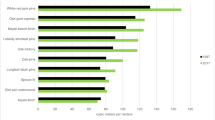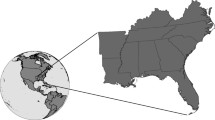Abstract
A widely used assumption in forestry is that thedemand for timber will exceed the maximum levelavailable from forests on a sustainable basis. In thisstudy, measurements of extracted timber and modeledforest productivity were used to investigate therelationship between harvested timber and naturalforest productivity for current conditions, and underglobal change scenario. The analysis was confined toconiferous forests and countries that have coniferousforests within their territories. Annual roundwoodproduction from the database of Food and AgricultureOrganization was used as an approximation of annualtimber harvest for each country. Annual stem primaryproductivity of coniferous forests was estimated usingthe BIOME-BGC model. Based on the current rates,annual timber extraction was extrapolated for eachcountry for the next 80 years. Then, on a countrybasis, the timber harvest was related to the modeledforest stem productivity, assuming that the area ofconiferous forest would stay unchanged for the next 80years.The results of this study suggest that globalconiferous forests currently produce more wood thanpeople consume, but that this gap will narrow in thefuture. The results also suggest that wood extractionmay reach forest regrowth by the middle of the nextcentury, even though most coniferous forests arelocated in high latitudes and may have an acceleratedstem growth associated with the joint effect ofclimate change and elevated carbon dioxideconcentration in the atmosphere.
Similar content being viewed by others
References
Ausubel, J. H.: 1998, The Nature of Earth: Robust, The Earth's Changing Land, GCTE-LUCC Open Science Conference on Global Change, Barcelona, Spain, IGBP.
Avery, T. E. and Burkhart, H. E.: 1994, Forest Measurements, 4th edn., McGraw-Hill, New York, p. 408.
Barger, R. L. and Benson, R. E.: 1979, Intensive Utilisation with Conventional Harvesting Systems, USDA Forest Service, Missoula, Montana.
Bengtsson, G., Holmlund, J., Lundström, A., and Sandwall, M.: 1989, Long-Term Forecasts of Timber Yields in Sweden, Swedish University of Agricultural Sciences, Department of Forest Survey, Sweden.
Boer, G. J., Flato, G. M., Reader, M. C., and Ramsden, D.: 1999, ‘A Transient Climate Change Simulation with Historical and Projected Greenhouse Gas and Aerosol Forcing: Experimental Design and Comparison with the Instrumental Record for the 20th Century’ Clim. Dyn. 16, 405–425.
Bugmann, H. K. M., Xiaodong, Y., Sykes, M. T., Martin, P., Lindener, M., Desanker, P. V., and Cumming, S. G.: 1996, ‘A Comparison of Forest Gap Models: Model Structure and Behaviour’ Clim. Change 34, 289–313.
Castro, F. D., Williamson, G. B., and Jesus, R. M. D.: 1993, ‘Radial Variation in the Wood Specific Gravity of Joannesia princeps: The Roles of Age and Diameter’ Biotropica 25, 176–182.
Churkina, G. and Running, S. W.: 1998, ‘Contrasting Climatic Controls on the Estimated Productivity of Different Biomes’ ECOSYSTEMS 1, 206–215.
Clutter, J. L., Fortson, J. C., Pienaar, L. V., Brister, L. V., and Bailey, R. L.: 1983, Timber Management: A Quantitative Approach, John Wiley & Sons, New York, p. 333.
Dean, T. J. and Baldwin, V. C.: 1996, ‘The Relationship between Reineke's Stand-Density Index and Physical Stem Mechanics’ For. Ecol. Manage. 81, 25–34.
DeFries, R., Hansen, M., Townshend, J., and Sohlberg, R.: 1998, ‘Global Land Cover Classification at 8 km Spatial Resolution: The Use of Training Data Derived from Landsat Imagery in Decision Tree Classifiers’ Int. J. Remote Sens. 19, 3141–3168.
Dentener, F. J. and Crutzen, P. J.: 1993, ‘Reaction of N2O5 on Tropospheric Aerosols: Impact on Global Distribution of NOx, O3, and OH’ J. Geophys. Res. 98, 7149–7163.
Dentener, F. J. and Crutzen, P. J.: 1994, ‘Three Dimensional Model of the Global Ammonia Cycle’ J. Atmos. Chem. 19, 331–369.
ECE/FAO: 1994, International Forest Fire News, ESE/FAO Agriculture and Timber Division, Geneva.
Elfving, B., Tegnhammar, L., and Tveite, B.: 1996, ‘Studies on Growth Trends of Forests in Sweden and Norway’ in Spiecker, H., Mielikäinen, K., Köhl, M., and Skovsgaard, J. P. (eds.), Growth Trends in European Forests, Springer-Verlag, Berlin, pp. 61–70.
FAO: 1997, FAOSTAT: Forestry Data, Food and Agriculture Organization of the United Nations.
Harmon, M. E., Ferrell, W. K., and Franklin, J. F.: 1990, ‘Effects on Carbon Storage of Conversion of Old-Growth Forests to Young Forests’ Science 247, 699–702.
Holland, E. A., Braswell, B. H., Lamarque, J.-F., Townsend, A., Sulzman, J., Müller, J.-F., Dentener, F., Brasseur, G., Levy II, H., Penner, J. E., and Roelofs, G.-J.: 1997, ‘Variation in the Predicted Spatial Distribution of Atmospheric Nitrogen Deposition and their Impact on Carbon Uptake by Terrestrial Ecosystems’ J. Geophys. Res. 102, 15849–15866.
Hunt, E. R. J., Piper, S. C., Nemani, R., Keeling, C. D., Otto, R. D., and Running, S. W.: 1996, ‘Global Net Carbon Exchange and Intra-Annual Atmospheric CO2 Concentrations Predicted by an Ecosystem Process Model and Three-Dimensional Atmospheric Transport Model’ Global Biogeochem. Cycles 10, 431–456.
Isaev, A. C., Korovin, G. N., Suhih, V. I., Titov, S. P., Ytkin, A. I., Golub, A. A., Zamolodchikov, D. G., and Prjazhnikov, A. A.: 1996, Ecological Problems of Carbon Dioxide Assimilation by the Means of Forest Restoration and Planting in Russia, Center for Russian Ecological Policy, Moscow, p. 155.
Kauppi, P. E., Mielikäinen, K., and Kuusela, K.: 1992, ‘Biomass and Carbon Budget of European Forests, 1971 to 1990’ Science 256, 70–74.
Khasa, P. D., Li, P., Magnussen, S., and Bousquet, J.: 1995, ‘Early Evaluation of Racosperma suriculiforme and R. mangium Provenance Trials on Four Sites in Zaire’ For. Ecol. Manage. 78, 99–113.
Kimball, J. S., Running, S. W., and Nemani, R.: 1997, ‘An Improved Method for Estimating Surface Humidity from Daily Minimum Temperature’ Agric. For. Meteorol. 85, 87–98.
Kolchugina, T. P. and Vinson, T. S.: 1993, ‘Comparison of Two Methods to Assess the Carbon Budget of Forest Biomes in the Former Soviet Union’ Water Air Soil Pollut. 70, 207–221.
Kolchugina, T. P. and Vinson, T. S.: 1995, ‘Role of Russian Forests in the Global Carbon Balance’ AMBIO 24, 258–264.
Kolchugina, T. P. and Vinson, T. S.: 1998, ‘The Future Role of Russian Forests in the Global Carbon Balance’ AMBIO 27, 579–580.
Korol, R. L., Running, S. W., Milner, K., and Hunt, E. R.: 1991, ‘Testing a Mechanistic Carbon Balance Model against Observed Tree Growth’ Can. J. Forest Res. 21, 1098–1105.
Korovin, G. N.: 1996, ‘Analysis of the Distribution of Forest Fires in Russia’ in Goldammer, J. G. and Furyaev, V. V. (eds.), Fire in Ecosystems of Boreal Eurasia, Kluwer Academic Publishers, Dordrecht, pp. 112–128.
Laarman, J. G. and Sedjo, R. A.: 1992, Global Forests: Issues for Six Billion People, McGraw-Hill, Inc., New York, p. 337.
Lelieveld, J., Crutzen, P. J., and Dentener, F. J.: 1998, ‘Changing Concentration. Lifetime and Climate Forcing of Atmospheric Methane’ Tellus 50b, 128–150.
Lowe, J. J., Power, K., and Gray, S. L.: 1994, Canada's Forest Inventory 1991, Petawawa National Forest Institute, Ontario.
Mackenzie, F. T. and Mackenzie, J. A.: 1995, Our Changing Planet: An Introduction to Earth System Science and Global Environmental Change, Prentice Hall, New Jersey, p. 387.
McDonald, S. S., Williamson, G. B., and Wiemann, M. C.: 1995, ‘Wood Specific Gravity and Anatomy in Helicarpus appendiculatus (Tiliaceae)’ Amer. J. Botany 82, 855–861.
McFarlane, N. A., Boer, G. J., Blanchet, J.-P., and Lazare, M.: 1992, ‘The Canadian Climate Centre Second-Generation General CirculationModel and its Equilibrium Climate’ J. Climate 5, 1013–1044.
Mielikäinen, K. and Sennov, S. N.: 1996, ‘Growth Trends of Forests in Finland and North-Western Russia’ in Spiecker, H., Mielikäinen, K., Köhl, M., and Skovsgaard, J. P. (eds.), Growth Trends in European Forests, Springer-Verlag, Berlin, pp. 19–27.
Milner, K. S., Running, S. W., and Coble, D. W.: 1996, ‘A Biophysical Soil-Site Model for Estimating Potential Productivity of Forested Landscapes’ Can. J. Forest Res. 26, 1174–1186.
Myneni, R. B., Keeling, C. D., Tucker, C. J., Asrar, G., and Nemani, R. R.: 1997, ‘Increased Plant Growth in the Northern High Latitudes from 1981 to 1991’ Nature 386, 698–702.
Piper, S. C. and Stewart, E. F.: 1996, ‘A Gridded Global Data Set of Daily Temperature and Precipitation for Terrestrial Biospheric Modeling’ Global Biogeochem. Cycles 10, 757–782.
Powell, D. S., Failkner, J. L., Darr, D. R., Zhu, Z., and MacCleery, D. W.: 1994, Forest Resources of the United States, 1992, USDA Forest Service, Rocky Mountain forest and Range Experimental Station, Fort Collins.
Richardson, S. D.: 1990, Forests and Forestry in China: Changing Patterns in Resource Development, Island Press, Washington D.C., p. 352.
Riebsame, W. E., Meyer, W. B., and Turner II, B. L.: 1994, ‘Modeling Land Use and Cover as Part of Global Environmental Change’ Clim. Change 28, 45–64.
Rueda, R.: 1992, ‘Radial and Vertical Wood Specific Gravity in Ochroma pyramidale (Bombacaceae)’ Biotropica 24, 512–518.
Running, S. W.: 1994, ‘Testing FOREST-BGC Ecosystem Process Simulations across a Climatic Gradient in Oregon’ Ecol. Appl. 4, 238–247.
Running, S. W. and Hunt, E. R. J.: 1993, ‘Generalization of a Forest Ecosystem Process Model for Other Biomes, Biome-BGC, and an Application for Global-Scale Models’ in Ehleringer, J. R. and Field, C. B. (eds.), Scaling Physiological Processes: Leaf to Globe, Academic Press, San Diego, CA, pp. 141–158.
Running, S. W., Nemani, R. R., and Hungerford, R. D.: 1987, ‘Extrapolation of Synoptic Meteorological Data in Mountainous Terrain and its Use for Simulating Forest Evapotranspiration and Photosynthesis’ Can. J. Forest Res. 17, 472–483.
Sharma, N. P., Rowe, R., Openshaw, K., and Jacobson, M.: 1992, ‘World Forests in Perspective’ in Sharma, N. P. (ed.), Managing the World's Forests: Looking for Balance between Conservation and Development, Kendal/Hunt Publishing Company, Dubuque, pp. 17–32.
Skovsgaard, J. P. and Henriksen, H. A.: 1996, ‘Increasing Site Productivity during Consecutive Generations of Naturally Regenerated and Planted Beech (Fagus sylvatica L.) in Denmark’ in Spiecker, H., Mielikäinen, K., Köhl, M., and Skovsgaard, J. P. (eds.), Growth Trends in European Forests, Springer-Verlag, Berlin, pp. 89–98.
Smith, W. H.: 1990, Air Pollution and Forests: Interaction between Air Contaminants and Forest Ecosystems, Springer-Verlag, New York, p. 618.
Stocks, B. J.: 1991, ‘The Extent and Impact of Forest Fires in Northern Circumpolar Countries’ in Levin, J. S. (ed.), Global Biomass Burning: Atmospheric, Climatic, and Biospheric Implications, MIT Press, Cambridge, pp. 197–202.
Thornton, P. E.: 1998, Regional Ecosystem Simulation: Combining Surface-and Satellite-Based Observations to Study Linkages between Terrestrial Energy and Mass Budgets, Ph.D., University of Montana.
Thornton, P. E. and Running, S. W.: 1999, ‘An Improved Algorithm for Estimating Incident Daily Solar Radiation from Measurements of Temperature, Humidity, and Precipitation’ Agric. For. Meteorol. 93, 211–228.
Tomppo, E.: 1997, National Forest Inventory, Finnish Forest Research Institute METLA, Helsinki.
Turner, D. P., Koerper, G. J., Harmon, M. E., and Lee, J. J.: 1995a, ‘A Carbon Budget for Forests of the Conterminous United States’ Ecol. Appl. 5, 421–436.
Turner, D. P., Koerper, G. J., Harmon, M. E., and Lee, J. J.: 1995b, ‘Carbon Sequestration by Forests of the United States. Current Status and Projections to the Year 2040’ Tellus 47H, 232–239.
UN/ECE: 1997, Timber Database, United Nations Economic Commission for Europe.
Valendik, E. N.: 1996, ‘Temporal and Spatial Distribution of Forest Fires in Siberia’ in Goldammer, J. G. and Furyaev, V. V. (eds.), Fire in Ecosystems of Boreal Eurasia, Kluwer Academic Publishers, Dordrecht, pp. 129–138.
Waring, R. and Running, S. W.: 1998, Forest Ecosystems: Analysis at Multiple Scales, Academic Press, New York, p. 370.
Wernick, I. K., Waggoner, P. E., and Ausubel, J. H.: 1998, ‘Searching for Leverage to Conserve Forests: The Industrial Ecology of Wood Products in the United States’ J. Indust. Ecol. 1, 125–145.
Williams, M.: 1994, ‘Forests and Tree Cover’ in Meyer, W. B. and Turner II, B. L. (eds.), Changes in Land Use and Land Cover: A Global Perspective, Cambridge University Press, Cambridge, pp. 95–124.
WorldBank: 1997, Russia: Forest Policy during Transition, The World Bank, Washington, D.C., p. 279.
WRI: 1996, World Resources: a Guide to the Global Environment, New York.
Yanchuk, A. D. and Kiss, G. K.: 1993, ‘Genetic Variation in Growth and Wood Specific Gravity and its Utility in the Improvement of Interior Spruce in British Colombia’ Silvae Genetica 42, 141–148.
Young, R. A. and Giese, R. L.: 1990, Introduction to Forest Science, Wiley and Sons, New York, p. 586.
Author information
Authors and Affiliations
Rights and permissions
About this article
Cite this article
Churkina, G., Running, S. Investigating the Balance between Timber Harvest and Productivity of Global Coniferous Forests under Global Change. Climatic Change 47, 167–191 (2000). https://doi.org/10.1023/A:1005620808273
Issue Date:
DOI: https://doi.org/10.1023/A:1005620808273




